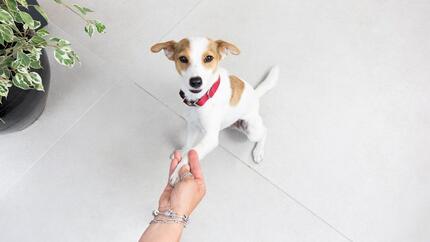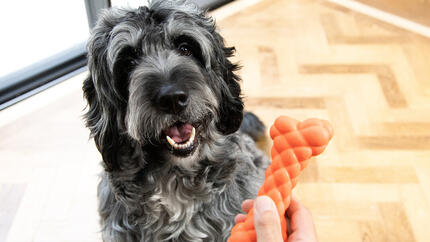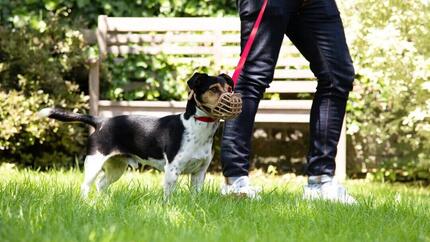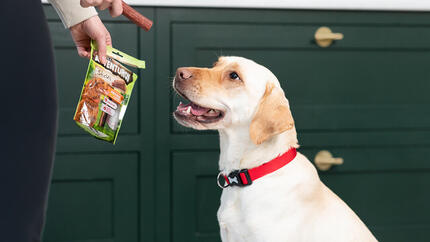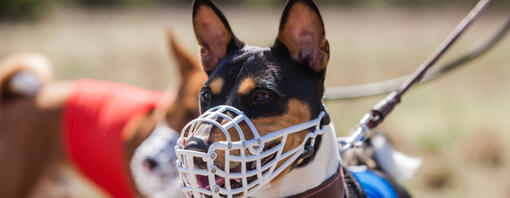
Dog muzzles often get a bad rap, but did you know there are actually quite a few benefits to wearing them for certain types of dogs and in some cases, legal requirements? Find out more about them and our dog muzzle training tips with this guide.
Dog muzzles are fantastic! We know that they get a mixed response from people, but we also know how important they are and have written this article to help you with your dog muzzle training. If you read that and thought, ‘my dog doesn’t need a muzzle,’ then this article is for you.
Not only are muzzles perfect for dogs that might be a little bit grumpy, reactive or worried when they’re out and about, they’re also often important to be able to use at the vet's in order to keep everyone safe. Dogs often behave unpredictably when they are in pain – and a vet’s practise can be a scary place. Your dog doesn’t know that your vet is trying to help them and can easily get a bit toothy in their fear or panic.
For some dogs in the UK, the law dictates that they must be muzzled – these are dogs who have been registered under the Dangerous Dogs Act 1991 Section 1.
Plus, some dogs (such as Greyhounds – especially ex racers - and other sight hounds) can be a serious threat to cats or other animals, and so wearing a muzzle when they are out and about prevents them from catching, injuring, or killing smaller mammals.
And of course, there are those dogs who will eat everything they find when they are out and about – however inappropriate (stones, sticks, people’s picnics…!). For them a muzzle can prevent them from being able to do this while you work on their training.
There are many reasons your dog might benefit from wearing a muzzle and if they have been introduced to it gradually and learnt to love their muzzle then any stress that could be accompanied by wearing one goes away.
Why do some dogs wear muzzles?
Some dogs need to wear muzzles and most of the time, it’s not because they’ve ever bitten anyone or attacked another dog. There are dogs in the UK that are required, by law, to wear a muzzle in public because of their breed, not their bite history. Some ex-racing greyhounds wear muzzles because they have endured years of chasing something small and furry and that’s a hard habit to break. Some dogs wear one because vets and trainers recommend it when they are learning not to eat potentially dangerous objects, like stones or litter. Some dogs wear one because they need space and can behave reactively, and people tend to give dogs a wide berth if they’re wearing a muzzle.
There are misconceptions about dog muzzles, there are judgements and there are quite often some unhelpful comments about them, but when did that stop you from doing your best for your dog?! The more we can all raise awareness about the positives of muzzles, the better!
You could face a situation where your dog needs to be muzzled. You don’t know what the future holds and if you’re in a situation where your dog needs a muzzle as a matter of urgency; they won’t be feeling excited about one landing on their face. Many dogs will find themselves in the vets one day with an injury – or just having to be handled by a stranger in a way they are not comfortable with. Being able to wear a muzzle happily will make it safer and more stress-free for all.
You can prepare them and take that stress away for them.
Baskerville muzzles
There are various types of muzzles but from most dogs, the best option is a Baskerville muzzle. Baskerville type muzzles are popular, safe, and lightweight muzzles that allow your dog to breathe, pant and drink while wearing them.
Never use a muzzle that clamps your dog’s mouth shut for anything other than a very short-term measure (such as an emergency at the vet), as that affects their breathing and leaves them unable to drink. With the Baskerville muzzle, they can take treats and drink, so once they’ve learned to be comfortable and happy in it, they’re not prevented from enjoying life while wearing one.
They come in a wide range of sizes (both width and length) – and there are special fittings for short nosed dogs, and even double ended versions for those expert scavengers.
You’ll need to measure your dog’s snout to make sure you get the correct size and please do that in the comfort of your own home, not in the aisle of a pet shop. Then, when you’re shopping, stock up on squeezy cheese or liver paste as this will help make your dog’s muzzle training simple and fun.
If you take on an ex-racing Greyhound, they will be used to wearing a muzzle and so a lot of the training work has already been done for you.
There are lot of new brands of muzzle appearing on the market – that come in a variety of colours and designs, so they look more appealing. Always make sure that whatever brand you choose, they are comfortable (so won’t rub), can’t be easily pulled off, and allow your dog to breathe, pant and drink – and of course, take treats.
Dog muzzle training tips
Prepare the muzzle by adjusting the straps OFF your dog. You can hold it close to their head and get an idea of how long the straps need to be. You don’t want to be pulling around on the straps when it is on your dog’s nose. Start off a bit bigger than you think it needs to be – you can always shorten the straps later.
Put a little bit of a squeezy treat at the bottom of the muzzle, on the inside! Hold it out for your dog and let them sniff, putting their nose into the muzzle in their own time. Don’t do anything other than practise this until your dog doesn’t think twice about nose-diving into the muzzle. Don’t try and fasten it, don’t push it onto your dog’s nose, just be patient and enjoy watching your dog explore.
With the squeezy treat smeared on the bottom of the muzzle, your dog will get used to keeping their nose in it for longer periods of time – and you can always add some from the outside, so they learn that having this thing on their nose, brings ‘good things’.
As they become more comfortable, you can start to move the straps, fasten it briefly (and quietly) - giving lots of rewards and praise when it is on - until they are happy with it being on.
This is a good time for you to learn the best way to give your dog treats while they are wearing the muzzle – and what treats work best.
Once they are happy with this step, you can do a few training exercises with it on – like sits - so your dog learns to move about with the muzzle on. Now you are ready to put on your dog’s lead and start walking out and about with their new nose-wear. Remember to keep giving treats so they always think that having the muzzle on is a good thing.
Don’t forget this is all new to your dog – so be patient, take it slowly and always praise and reward them.
Don’t leave your dog wearing it around the house as there’s a strong chance they’ll try and take it off and become frustrated, which is counterproductive. You can however use this as a great opportunity to practice recall, loose lead walking or teach a new cue. Remember that your dog has to associate the dog muzzle with fun activities.
Top dog muzzle training tip: Sitting down holding the dog muzzle between your knees frees you up to get your dog used to the straps being moved and fastened, rather than trying to hold it and fasten it and keep your dog comfortable all at once.
When you’re ready, you can add a cue if you’d like to. A popular cue is ‘muzzle up’ so you can train your dog to come over to you and nosedive into their muzzle.
Practise doing this lots of times a day – even when you don’t plan to put it on or take your dog out. Keep building positive associations with the muzzle.
When you’re out with your muzzled dog, hold your head up high and be proud that you’re keeping your dog safe. You’ll be raising awareness through your actions and your relaxed, happy dog will challenge the stereotypes while you smile at the people glancing in your direction.
Looking for more dog training tips and advice? Read our article on the basic dog training commands, next!











